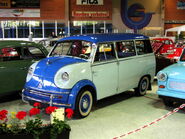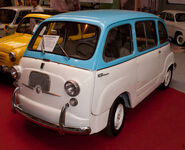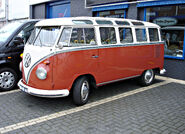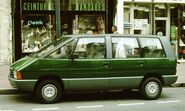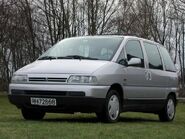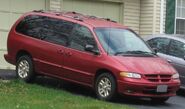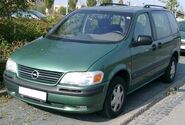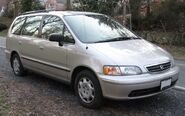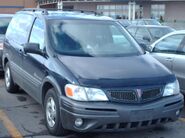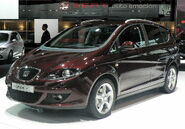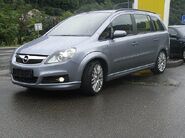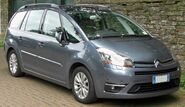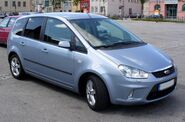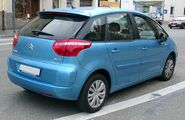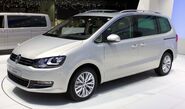- For the Austin Motor Company and British Leyland Mini based van, see Mini#Van.
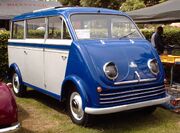
DKW Schnellaster (1949-1962), with front-wheel drive, transverse engine, flat floor, and multi-configurable seating
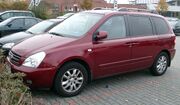
Kia Carnival/Sedona 2006, Gen II, a contemporary minivan with front-wheel drive, transverse engine, flat floor, and multi-configurable seating
Minivan is a type of automobile similar in shape to a van, designed for personal use. {not to be confused with the MINI van). Minivans are typically either two-box or one box designs for maximum interior volume — and are taller than a sedan, hatchback, SUV or a station wagon.
Worldwide, minivans are also marketed as multi-purpose vehicles (MPVs), people-carriers, people-movers, or multi-utility vehicles (MUVs).
The term[]
In Europe and India, "multi-purpose vehicle" (MPV) describes the general vehicle type without reference to its size. These are described with a word before the acronym: a "mini MPV" is derived from a supermini, a "compact MPV" is based on a small family car and a "large MPV" has about the same size as a large family car. In Asia, "multi-utility vehicle" (MUV) has more or less the same meaning as MPV. "People-carrier" and "people mover" describe both large MPVs and minibuses, but not smaller models.
Other terms are used in other English-speaking countries.
Characteristics[]
Overview[]
MPVs are usually between 1,600–1,800 millimetres (63–71 in) tall, which is around 200 mm (8 in) taller than a sedan, hatchback or a station wagon. The engine is mounted very close to the front edge of the car, and its elements are grouped higher than in other car types to minimize front overhang length. The rear overhang may be short as in a hatchback or long like in station wagons, changing the boot vs seat balance – the first option is more common in smaller minivans and the second in large minivans.
Seating[]
Seats are located higher than in lower cars with a higher H-point, giving passengers a more upright posture and providing more legroom.
Larger MPVs usually feature three seat rows, with two or three seats each: 2-3-2, 2-2-3 or 2-3-3 (front to rear) are the most common seating configurations. Smaller minivans tend to have two seat rows, with a traditional 2-3 configuration. There are some exceptions, like the Honda FR-V, Fiat Multipla and Mercedes-Benz R-Class which are six seaters (3-3 in the first two cases and 2-2-2 in the latter). On American models, Chrysler copied the short bench, long bench format of their large vans for most models. Other Americans followed suit. This setup allowed very easy access to the rear from the right side (these vans were initially all 3-door models). However, it led to tight seating in the second row. Captain's chairs (the format typically used on American conversion vans) soon began to gain popularity, beginning with top trim models and working its way down. Today, with 4-door models completely replacing 3-doors, the Captain chair setup has become the standard format, with many models no longer offering two bench seats.
MPVs may have seats, either benches or individual seats, that are designed to be relocated, removed, folded partially (on-floor) or folded completely under-floor — allowing variable seating capacity and cargo room.
Chassis and drivetrain[]
In contrast to vans, sport utility vehicles (SUV) and many crossover SUVs, most current MPVs are front-wheel drive. The main advantage is somewhat better traction than rear-wheel drive vehicles under slippery conditions like rain, snow and ice[citation needed]. This configuration also allows more inner area along the floor, due to the absence of the driveshaft hump. With rear seats removed, the cargo area in large minivans can hold a 4x8 ft sheet of drywall or plywood flat. Four-wheel drive was also introduced to minivans in North America with the Toyota Van Wagon 4WD and the Volkswagen Vanagon Syncro. Full-time all-wheel drive was introduced to North American minivans in the 1990 Ford Aerostar with the E-4WD option, and in 1991 with the introduction of the Toyota Previa All-Trac. The Toyota Van 4WD remains the only minivan offered for sale in the North American market with selective 4WD.
Most modern MPVs feature unibody architecture, which offers superior crashworthiness and a more comfortable ride than a body-on-frame chassis, and is typically lighter. The Chevrolet Astro / GMC Safari was the last body-on-frame rear-wheel drive minivan but is now discontinued.
In the United States, in order to be governed by more lenient safety and emissions regulations, minivans are classified as light trucks. Unlike their European counterparts, manual transmissions have disappeared due to lack of demand[citation needed]; 1995 was the last year for a manual transmission in the Ford Aerostar and Chrysler minivans and GM had discontinued the manual transmission in the Chevrolet Astro and GMC Safari some time before. The sole exception to this is the Mazda 5.
Doors[]
Door configuration for MPVs are highly variable. Access to the rear interior may be through one or two sliding or out-swing rear side doors. Early minivans featured one rear side sliding door on the passenger's side, similar to full-sized passenger vans in the early 80's. Many current minivans feature rear sliding doors on both sides; swinging doors are the norm for European and Japanese minivans, while most American models feature sliding doors. Some models featuring power sliding doors.
Segments[]
MPVs can be roughly classified in three or four segments: large, compact, mini and micro. Models of all segments are present in Europe, the Americas and parts of Asia.
Large MPVs are those above 4600 mm (180 in) long. Nearly every minivan sold in the United States belongs to this segment, so they are simply called minivans there. The first European MPV also belonged to this segment, and later similar models were named likewise until smaller models appeared; now these models are called "large MPVs". Examples are the Dodge Caravan, Honda Odyssey, Volkswagen Sharan and Eurovan.
Compact MPVs have a length of between 4,200–4,600 millimetres (170–180 in). Such models enjoyed some popularity in the United States in the late 1980s and early 1990s, for example the Mitsubishi Expo and Nissan Axxess. In 1996, the Renault Scénic was released in Europe and its success made mainstream automakers produce them in large quantities, usually based on small family car platforms and with both two and three-row seats. As of 2007, the only compact minivans available in the United States are the Mazda5 and Kia Rondo.
Mini MPVs are under 4100 mm (160 in) long, and were introduced in the early first decade of the 21st century. These models are based on supermini platforms and have different styles depending on markets: Japanese models are more boxy while Europeans have the bonnet and windshield almost parallel. Examples of mini MPVs are the Opel/Vauxhall Meriva, Citroen C3 Picasso, Fiat Idea, Toyota bB and Nissan Cube.
Tall city cars and kei cars like the Hyundai Atos, Chevrolet Matiz, Chery QQ and Suzuki Wagon R have also been called mini MPVs or "microvans" because of their increased height over traditional hatchbacks. Others believe they are too similar in design with other small cars, so they should be described as the same kind of cars.
Early minivans models may be smaller than modern models, but still fit into the child subsegment; the first-generation Renault Espace introduced in 1984 would be classified nowadays as a compact MPV, but later generations grew in size and the Espace is now considered a large MPV. Indeed, it is expected that the next-generation Espace will be smaller in size than the current model.
History[]
Antecedents to the contemporary minivan include the Stout Scarab, which in 1936 featured a removable table and second row seats that turn 180 degrees to face the rear — a feature that Chrysler currently markets as Swivel ’n Go.[1]
The DKW Schnellaster, manufactured from 1949 to 1962 was a small monospace (or one-box) design featuring its front wheels set forward of the passenger cabin, a short, sloping aerodynamic hood, front wheel drive, transverse engine, flat load floor throughout with flexible seating and cargo accommodations — the key design ingredients that describe the modern minivan configuration popularized in such notable examples as the Renault Espace and Chrysler Voyager/Caravan minivans.[2]
Other predecessors of minivans were compact vans. In 1950, the Volkswagen Type 2 adapted a bus-shaped body to the compact Volkswagen Beetle. It placed the driver above the front wheels, sitting behind a flat nose, with the engine mounted at the rear. The two hinged side doors were opposite to the driver's side, with optional doors on the driver's side, Fiat built a similar vehicle, Multipla based on the Fiat 600 with the same engine and door layout. Japanese and American manufacturers responded with compact vans since the 1960s. Usually based on front-engined compact cars with a FMR layout, the engine was mounted behind or under the front seat with a flat, vertical nose. Examples include the Ford Econoline, Chevrolet Van, Suzuki Carry, Toyota Hiace and Subaru Sambar. When Volkswagen introduced a sliding side door on their van in 1968, it then had all the features that would later come to define a minivan: compact length, three rows of forward-facing seats, station wagon-style top-hinged tailgate/liftgate, sliding side door, passenger car base.
As the American vehicles such as the Econoline evolved into larger full-sized vans, the term minivan came to use in North America, when Toyota and Chrysler launched their respective smaller minivan products for the 1984 model year. It is interesting that this could be seen as a Detroit response to the "Baby-Boomlet" when the Baby-Boom children were starting to have children. The Toyota Van and Dodge Caravan / Plymouth Voyager featured very different structural designs: the Dodge Caravan / Plymouth Voyager had a FF layout and unibody construction, while the Toyota Van Wagon featured a FMR layout and was built on a body-on-frame chassis. The Chevrolet Astro / GMC Safari and Ford Aerostar were introduced for the 1985 model year with FR layout.
A European minivan design was conceived in the late 1970s by the Rootes Group in partnership with the French automaker Matra (which was also affiliated with Simca, the former French subsidiary of the Chrysler Corporation, sold in 1977 to the PSA Group). The Matra design was originally intended to be sold as a Talbot and be a replacement for the Talbot-Matra Rancho. Early prototypes were designed to use Simca parts and a grille like the Simca 1307. Matra took their idea to Peugeot who thought it too expensive and risky so the project was then presented to Renault, becoming the Renault Espace introduced in 1984. The Renault had traditional hinged car doors on both sides. Chrysler had also been developing a minivan based on the Chrysler K platform, releasing the boxy Dodge Caravan / Plymouth Voyager earlier than the Espace, in 1983.
Minivan Gallery[]
Minivans by market[]
North America[]
Shortly after their arrival, the Chrysler minivans competed against the truck-based front-engine, rear drive Chevrolet Astro, GMC Safari (based on a reworked 1st generation S-10 platform), and Ford Aerostar (based on a reworked 1st-generation Ranger platform). Utilizing the transverse-mounted engine, front-wheel drive, uni-body construction and "one-box" design, the Chrysler minivans offered better fuel-economy, traction, size, and driving characteristics. Nissan and Mitsubishi also introduced minivans to North America; but like the Toyota Van Wagon, they had poor rear drive traction, had a bouncy ride due to the short wheelbase, and one had to exit the vehicle to walk from the front seats to the back seats.
In 1989, Mazda introduced the MPV, which featured a swing-out door with roll-down windows and was the first Japanese minivan with a front engine.
General Motors introduced the Chevrolet Lumina APV, Oldsmobile Silhouette, and Pontiac Trans Sport in 1990. These minivans were GM's first front-wheel drive minivans; built on a reworked version of GM's 1980's A-platform — with composite plastic body panels, a cab-forward nose, steeply raked windshields, and deep dashboards.
That same year, Toyota introduced the Previa. The Toyota Previa had a four-cylinder engine located under the floor of the vehicle, mounted nearly flat on its side, rather than straight up and down like in its predecessor. This allowed passengers to pass from the front seats to the back without exiting the vehicle.
Ford and Nissan introduced models in 1993 with front-wheel drive, the Mercury Villager and Nissan Quest respectively. These minivans featured car-based platforms and V6 engines. Ford introduced a slightly larger front-wheel drive minivan (based on a reworked version of the 1980s Taurus platform) called the Windstar in 1994.
In 1995 Honda introduced the Odyssey, based on the Honda Accord with outswing doors with roll-down second row windows, a rear seat that folded into the floor, and a 140 hp inline four engine.
According to Autodata, in 2006 Chrysler, Honda, and Toyota comprised 72% of the United States minivan market. General Motors and Ford made up 17%, Kia Sedona and Hyundai Entourage sales made up 5%, and the Nissan Quest was 3%. By 2008, most North American minivans had adopted the size and configuration of the long-wheelbase Chrysler vans, with Chrysler dropping their shorter models as well. In 2008, only the Kia Sedona and Chevrolet Uplander offered both short and long-wheelbase configurations. In 2008, Volkswagen debuted the Routan, a rebadged variant of the Chrysler RT platform minivans.
Engines[]
During the 1980s, North American minivans generally had four-cylinder engines and were slow and under-powered when compared with sport utility vehicles, but were more fuel efficient. Such vehicles typically had poor performance, especially since manual transmissions were (and still are) rare in minivans. The minivans also often had a higher rate of problems than vehicles with larger engines. Some minivans were notorious for having problems with their transaxles, as the vehicles were substantially heavier than the sedans for which their powertrains were originally designed. With the shift in the 1990s towards heavier, long-wheelbase models and light towing, V6 engines became more common and some automakers dropped their four-cylinder engines from their lineup. The Chevrolet Astro, the last surviving truck-based mid-size van, was popular for towing applications because of its frame and up to 4.3 liter V6, and some owners even installed their own V8 engines.
Europe[]
Apart from the Chrysler Minivans, the Renault did not have any direct rival during the 1980s. Other mainstream automakers began to develop multi-purpose vehicles designed with European tastes in mind. PSA Peugeot Citroën and the Fiat Group founded a joint-venture, Sevel, and released in 1994 the eurovan under the nameplates Citroën Evasion (marked as Synergie in the UK), Peugeot 806, Fiat Ulysse and Lancia Zeta. The Ford and the Volkswagen Group JV Auto-Europa similarly co-developed models on a common chassis and built them in a shared-plant in Palmela, Portugal. While the VW/SEAT/Ford model had alength of 4,635 mm (182.5 in), the Espace and the eurovan were around 200 mm (7.9 in) shorter and would be considered today as compact MPVs. All of them were available as seven-seaters and the seats could be folded and removed. These models would be later called "large MPVs".
The trend towards compact MPVs began in 1996 with the launch of the Renault Scénic and Opel Zafira. Compact MPVs were cars with tall bodies but based on the chassis and engines of a small family car (in the case of the Scénic, the Renault Mégane). The runaway success of the Scénic saw the car spawn a multitude of similar vehicles, like the Opel Zafira, the Citroën Xsara Picasso, the Volkswagen Touran, the SEAT Altea, the Ford Focus C-Max, and the Nissan Almera Tino. By the mid-first decade of the 21st century virtually all mainstream automakers in Europe had a compact MPV in their range. Citroën's Xsara Picasso was a strong seller and was followed up with the C4 Picasso range with 5 and 7 seat variants, a line-up which resulted in Citroën becoming Europe's largest MPV manufacturer.[3]
Also in the mid-first decade of the 21st century, automakers began to use MPV-style designs on supermini-based chassis. Examples of mini MPVs them are the Opel/Vauxhall Meriva, based on the Corsa, the Citroën C3 Picasso, derived from the C3, and the Fiat Idea, derived from the Punto platform.
In 2000, the Auto-Europa triplets (Galaxy, Sharan and Alhambra) were heavily face-lifted. More recently, Ford quit the Auto-Europa joint venture to make its own Galaxy sharing many parts with the Ford S-MAX, another MPV. However the Auto-Europa production was not dissolved as VW and SEAT continued with their own models.
In 2010, the second-generation Volkswagen Sharan and SEAT Alhambra were presented, making the debut of the brand new Volkswagen group's MQB platform, and like their predecessors did, they were both again almost identical in design one to another, with the exception of the front fascias, rear ends and some minor details. The production site would still be the Auto-Europa site in Portugal.
Engines[]
European Minivans (MPVs) are generally powered by four-cylinder engines, originally a mix of petrol and diesel units, but with petrol engines becoming increasingly rare as diesels have improved. V6 engines are rare due to the increased fuel consumption of larger engines being considered unacceptable with high fuel prices.
Asia[]
In the ASEAN nations, China and India, multi-utility vehicles tend to be smaller than North American minivans and European MPVs. Compact MUVs are more popular than models of other sizes.
They also differ in that they need to cope with uneven terrain as opposed to paved highways. Models from local manufacturers are usually based on Japanese designs from Suzuki, Daihatsu and Toyota. Popular models include Toyota Picnic, Toyota Previa, Mazda 8 and Honda StepWGN.
MUVs vary widely in configuration. Whilst some MUVs might be replicas of European MPVs (such as the European Ford Fusion) or American-style minivans (like the Toyota Innova), in some cases MUVs are similar to SUVs (such as the Chevrolet Tavera).
Other examples of MUVs are the Maruti Versa, Isuzu Panther, Toyota Avanza, Mahindra Xylo, Toyota Qualis and Toyota Innova.
In Korea, full-size minivans are popular. Korean made examples include the Kia Carnival and SsangYong Rodius.
In Malaysia, the Proton Exora is Proton's first MPV and the Perodua Alza is Perodua's first MPV.
See also[]
- List of van models
- Van
- Chrysler Minivans
- Car body styles
- Mini MPV
- Compact MPV
- Crossover SUV
- Leisure activity vehicle
- Station wagon
References[]
- ↑ "A Visionary’s Minivan Arrived Decades Too Soon", The New York Times, Phil Patton, January 6, 2008 (January 6, 2008).
- ↑ "The Mother Of All Modern Minivans: 1949 DKW Schnellaster". The Truth About Cars, Paul Niedermeyer, March 29, 2010.
- ↑ "Top Gear – Citroën Picasso".
External links[]
| This page uses some content from Wikipedia. The original article was at Minivan. The list of authors can be seen in the page history. As with Tractor & Construction Plant Wiki, the text of Wikipedia is available under the Creative Commons by Attribution License and/or GNU Free Documentation License. Please check page history for when the original article was copied to Wikia |
